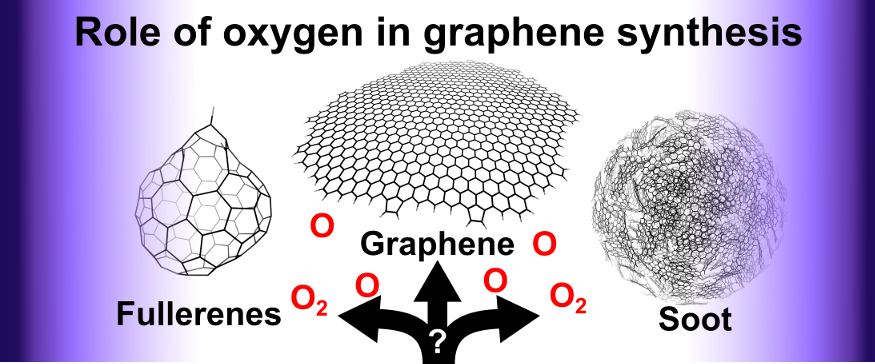The role of oxygenated species in the growth of graphene, fullerenes and carbonaceous particles
- Kinetic Monte Carlo simulations of carbonaceous materials.
- Graphene is produced in the presence of atomic oxygen.
- Fullerenes are produced in the presence of molecular oxygen.
- Partially-embedded five-member rings control curvature of carbonaceous material.
 The growth of carbonaceous materials was studied using a Kinetic Monte Carlo model that captures the growth and oxidation of six-member and partially-embedded five-member rings. A novel algorithm was used to resolve the migration of partially-embedded five-member rings around the edges of molecules. Circumcoronene molecules were grown at 1500 K and 1 atm in the presence of varying mole fractions of atomic and molecular oxygen and constant mole fractions of hydrogen and acetylene. The parameter space of the study covered the mole fraction of atomic and molecular oxygen in the ranges: 10-8 ≤ XO ≤ 10-1 and 10-6 ≤ XO2 ≤ 10-1. Four regions of carbon growth associated with different carbonaceous products were identified. Graphene was formed in the presence of high mole fractions of atomic oxygen (10-4 < XO ≤ 10-2). Fullerenes were formed in the presence of low mole fractions of atomic oxygen and high mole fractions of molecular oxygen (XO ≤ 10-4 and 10-2 < XO2 ≤10-1). Low mole fractions of both atomic and molecular oxygen (XO ≤ 10-4 and XO2 ≤ 10-2) resulted in structures that became curved as time progressed. The highest mole fractions of atomic oxygen (XO > 10-2) produced small structures due to oxidation of the molecules. The production and consumption of partially-embedded five-member rings appear to explain the formation of the observed structures. The oxidation of partially-embedded five-member rings leaves behind armchair sites that grow to form large and flat structures that resemble graphene. Formation and subsequent embedding of partially-embedded five-member rings result in curved structures that resemble fullerenes.
The growth of carbonaceous materials was studied using a Kinetic Monte Carlo model that captures the growth and oxidation of six-member and partially-embedded five-member rings. A novel algorithm was used to resolve the migration of partially-embedded five-member rings around the edges of molecules. Circumcoronene molecules were grown at 1500 K and 1 atm in the presence of varying mole fractions of atomic and molecular oxygen and constant mole fractions of hydrogen and acetylene. The parameter space of the study covered the mole fraction of atomic and molecular oxygen in the ranges: 10-8 ≤ XO ≤ 10-1 and 10-6 ≤ XO2 ≤ 10-1. Four regions of carbon growth associated with different carbonaceous products were identified. Graphene was formed in the presence of high mole fractions of atomic oxygen (10-4 < XO ≤ 10-2). Fullerenes were formed in the presence of low mole fractions of atomic oxygen and high mole fractions of molecular oxygen (XO ≤ 10-4 and 10-2 < XO2 ≤10-1). Low mole fractions of both atomic and molecular oxygen (XO ≤ 10-4 and XO2 ≤ 10-2) resulted in structures that became curved as time progressed. The highest mole fractions of atomic oxygen (XO > 10-2) produced small structures due to oxidation of the molecules. The production and consumption of partially-embedded five-member rings appear to explain the formation of the observed structures. The oxidation of partially-embedded five-member rings leaves behind armchair sites that grow to form large and flat structures that resemble graphene. Formation and subsequent embedding of partially-embedded five-member rings result in curved structures that resemble fullerenes.
- This paper draws from preprint 269: The role of oxygenated species in the growth of graphene, fullerenes and carbonaceous particles
- Access the article at the publisher: DOI: 10.1016/j.carbon.2021.05.052



